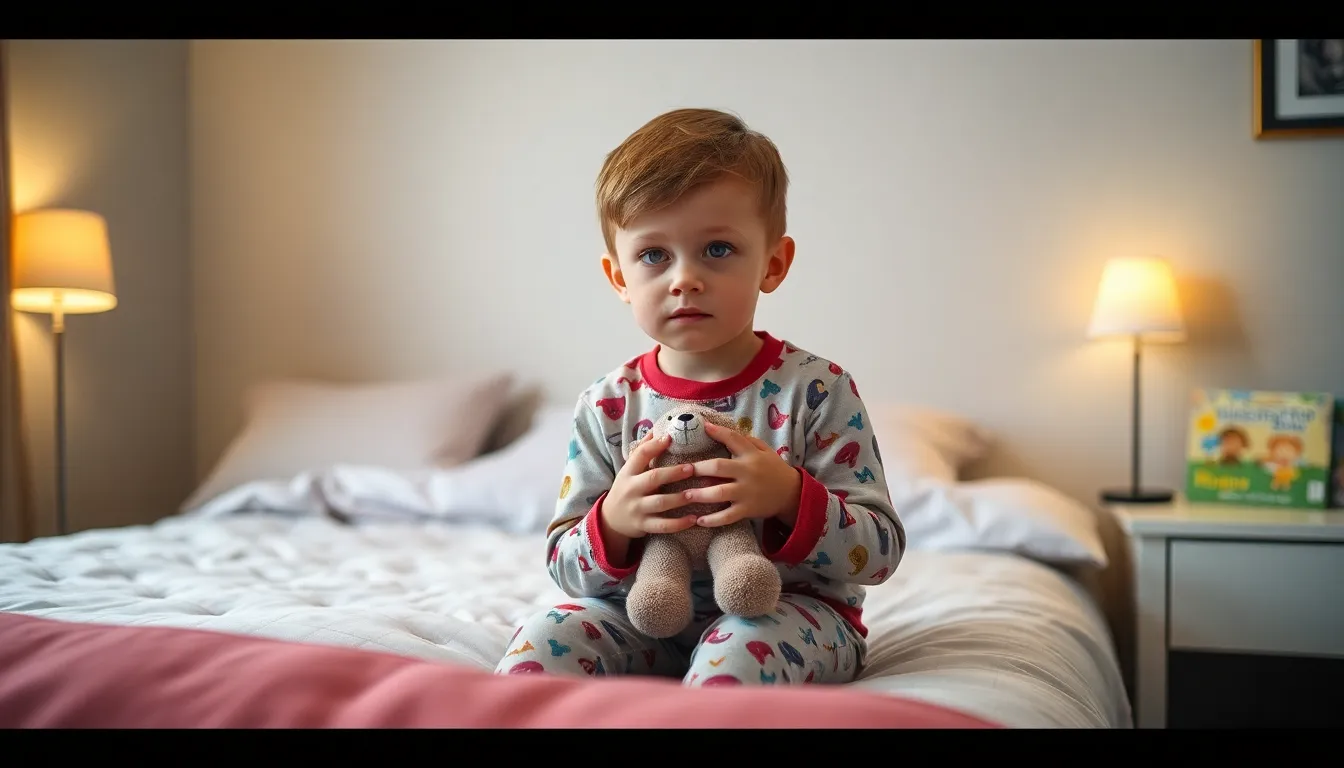Bedwetting might seem like a topic best left for childhood memories or awkward family gatherings, but the reality is far more common than most people think. With statistics revealing that nearly 1 in 6 kids ages 5 to 12 experience bedwetting, it’s clear this issue affects many families. While it might feel like a rite of passage for some, for others, it can be a source of stress and embarrassment.
Understanding bedwetting statistics not only sheds light on this widespread phenomenon but also helps debunk myths and stigmas that surround it. So whether you’re a parent navigating the nighttime trenches or simply curious about this quirky topic, knowing the facts can empower you. After all, knowledge is power, and who wouldn’t want to be the superhero of bedtime?
Table of Contents
ToggleOverview Of Bedwetting Statistics
Bedwetting affects a significant number of children. Nearly 1 in 6 children aged 5 to 12 experience this condition. These statistics highlight the commonality of bedwetting, showing that it’s not an unusual occurrence.
Prevalence rates vary among different age groups. Approximately 15% of 5-year-olds wet the bed, while this figure decreases to about 5% for children aged 10. Among teenagers, about 1% experience bedwetting, which indicates a natural decline as children mature.
Gender differences also exist in bedwetting statistics. Boys are more likely to wet the bed than girls, with studies showing a ratio of 2:1. This disparity may be due to developmental factors that influence bladder control.
Cultural factors influence bedwetting occurrences as well. Certain cultures might view bedwetting differently, affecting how families approach the issue. Yet, regardless of culture, communication and support play vital roles in managing the condition.
Anxiety and stress can exacerbate bedwetting. Studies indicate that children under stress have a higher likelihood of experiencing bedwetting episodes. Recognizing this connection enables parents to create supportive environments that foster emotional well-being.
Studies show that most children outgrow bedwetting without intervention. Research suggests that nearly 15% of children resolve the issue by age 6, and the percentage increases with age. Parents should remember that patience and understanding are crucial during this phase.
Statistics on bedwetting encourage parents to seek guidance and reassurance. Educational resources can provide insights into effective management strategies. Empowering parents with knowledge contributes to reducing stigma around bedwetting, ultimately benefiting the child’s emotional health.
Prevalence Of Bedwetting

Bedwetting affects a significant number of children, with nearly 1 in 6 kids aged 5 to 12 experiencing this condition. Understanding the prevalence rates provides a clearer picture of its commonality and impact.
Age Groups Affected
Different age groups show varying prevalence rates for bedwetting. Approximately 15% of 5-year-olds wet the bed, while that figure decreases to around 5% for 10-year-olds. By age 15, only about 1% of teenagers continue to experience bedwetting. Most children outgrow this issue naturally, with around 15% resolving it by age 6. Early childhood is crucial for addressing this challenge, as many kids move past bedwetting as they develop.
Gender Differences
Significant gender differences exist when it comes to bedwetting prevalence. Boys are twice as likely to wet the bed compared to girls, attributed to developmental factors that influence bladder control. This discrepancy highlights the need for tailored approaches in managing bedwetting in boys versus girls. Cultural perceptions can also shape how families respond, further complicating the issue. Awareness of these differences aids in fostering open discussions and effective support.
Trends In Bedwetting Over The Years
Tracking bedwetting trends reveals important insights over time. The prevalence among children has changed gradually, reflecting various influences.
Historical Data Comparison
Historical data shows bedwetting rates among children aged 5 to 12 fluctuate. Around 15% of 5-year-olds experienced this issue in prior decades. Comparatively, 5% of 10-year-olds faced similar challenges, indicating a decrease as age increases. Research highlights that around 1% of teenagers continue to wet the bed. As boys are statistically more affected, the rate for them is roughly double that of girls. Developmental factors likely contribute to these gender differences. Overall, families have addressed bedwetting through diverse cultural responses, which has evolved over time.
Recent Studies Findings
Recent studies indicate that roughly 20% of children aged 5 to 7 experience bedwetting. About 10% of 8-year-olds and only 1-3% of older adolescents may face this challenge. Emotional issues such as anxiety often exacerbate bedwetting, underscoring the need for supportive environments. Many children naturally outgrow this condition by age 6, with only 15% still having issues by that age. Effective communication within families can significantly impact children’s well-being. Understanding and addressing these recent findings can help parents navigate bedwetting more effectively.
Impact Of Bedwetting On Families
Bedwetting affects not just children but also their families. Understanding its psychological and social impacts is crucial for effective support.
Psychological Effects
Children dealing with bedwetting often experience anxiety and low self-esteem. Many worry about their peers’ perceptions and fear embarrassment during sleepovers. Parents sometimes feel frustration and helplessness, which can strain family dynamics. Emotional distress can arise when children perceive bedwetting as a personal failure. Therapy and counseling options exist, providing essential coping mechanisms for families. Open conversations about feelings help foster emotional resilience in affected children. Empathy and reassurance can alleviate some psychological burdens, creating a supportive home environment.
Social Implications
Socially, bedwetting can lead to isolation for affected children. They may shy away from sleepovers, sports camps, or other group activities, fearing judgment. Peer relationships can suffer as children avoid situations where accidental wetting might occur. Parents may experience embarrassment or stigma, leading to secrecy and stress within the family. Understanding and compassion from peers enhance children’s social experiences and overall well-being. Encouraging inclusion and acceptance fosters a supportive community, positively impacting the child’s social confidence. Promoting awareness about bedwetting can reduce stigma and facilitate open discussions among families and friends.
Approaches To Managing Bedwetting
Managing bedwetting can involve various strategies that address both medical and lifestyle factors. Understanding these approaches enables parents to support their children effectively.
Medical Interventions
Medical professionals often recommend several interventions for persistent bedwetting. Alarm systems that notify children when they wet their beds act as effective tools for training the bladder. Medication, such as desmopressin, may also assist in reducing nighttime wetting by decreasing urine production. Pediatricians sometimes suggest behavior modification techniques that include reward systems for dry nights. In cases where underlying physical issues exist, targeted treatments can address specific medical concerns. Consulting a healthcare professional often proves vital in determining the most suitable approach tailored to the child’s needs.
Lifestyle Changes
Adjusting daily routines can significantly impact bedwetting management. Limiting fluid intake before bedtime often helps reduce nighttime accidents. Establishing a consistent bathroom routine before sleep encourages bladder training. Encouraging regular daytime bathroom visits can increase bladder capacity. Positive reinforcement for dry nights fosters motivation and boosts self-esteem. Additionally, creating a calm nighttime environment may decrease stress, which can exacerbate bedwetting. Families must focus on open communication to ensure children feel comfortable discussing their experiences.
Understanding bedwetting statistics is essential for parents and caregivers. By recognizing that it’s a common issue affecting many children, they can approach the situation with empathy and support. Awareness of the prevalence rates and the factors contributing to bedwetting can help destigmatize this condition.
Encouraging open communication within families fosters a supportive environment where children feel safe discussing their experiences. With appropriate strategies and interventions, most children naturally outgrow bedwetting. Ultimately, promoting understanding and compassion can significantly enhance the emotional well-being of affected children, helping them navigate this challenging phase of childhood.



